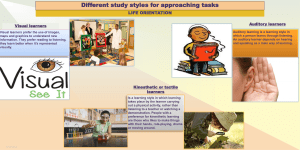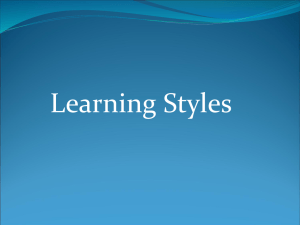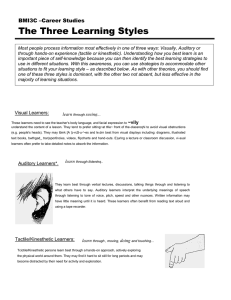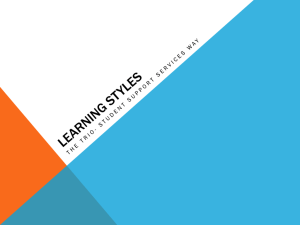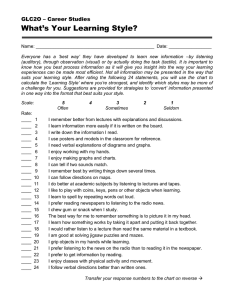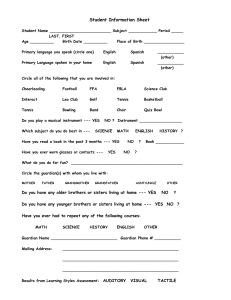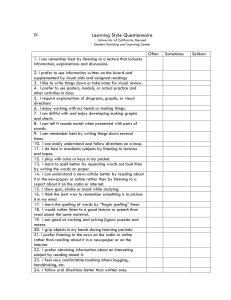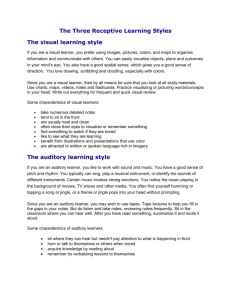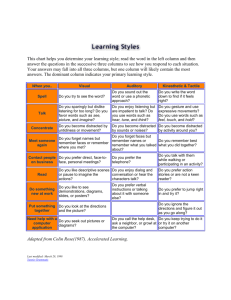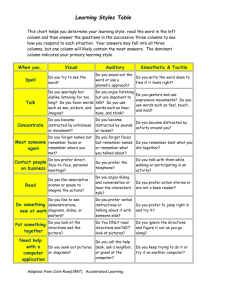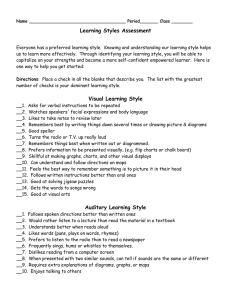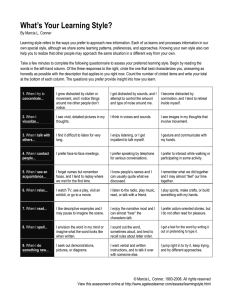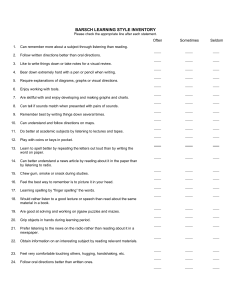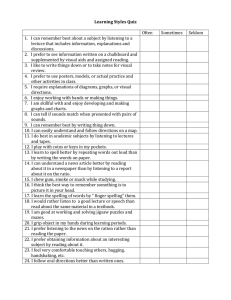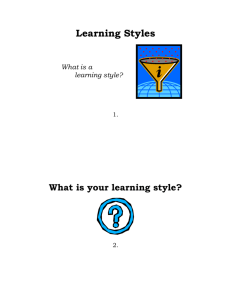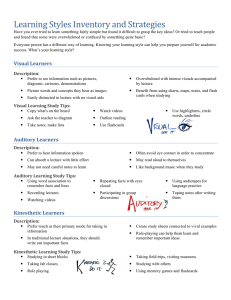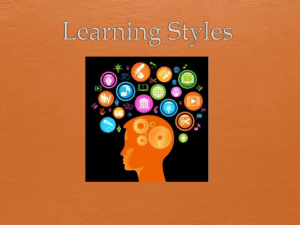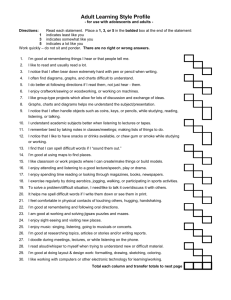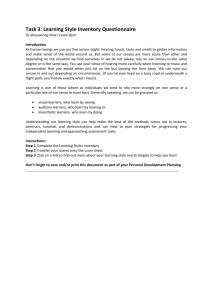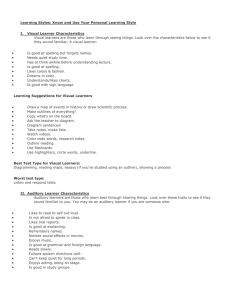Learning Styles
advertisement
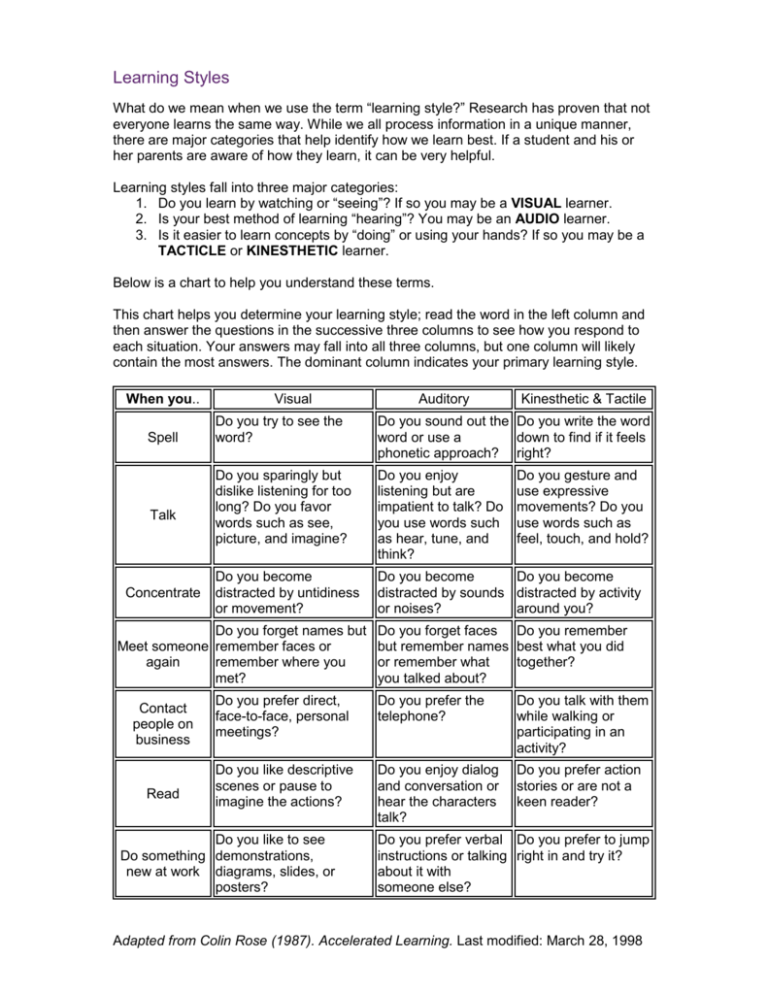
Learning Styles What do we mean when we use the term “learning style?” Research has proven that not everyone learns the same way. While we all process information in a unique manner, there are major categories that help identify how we learn best. If a student and his or her parents are aware of how they learn, it can be very helpful. Learning styles fall into three major categories: 1. Do you learn by watching or “seeing”? If so you may be a VISUAL learner. 2. Is your best method of learning “hearing”? You may be an AUDIO learner. 3. Is it easier to learn concepts by “doing” or using your hands? If so you may be a TACTICLE or KINESTHETIC learner. Below is a chart to help you understand these terms. This chart helps you determine your learning style; read the word in the left column and then answer the questions in the successive three columns to see how you respond to each situation. Your answers may fall into all three columns, but one column will likely contain the most answers. The dominant column indicates your primary learning style. When you.. Spell Talk Concentrate Visual Read Kinesthetic & Tactile Do you try to see the word? Do you sound out the Do you write the word word or use a down to find if it feels phonetic approach? right? Do you sparingly but dislike listening for too long? Do you favor words such as see, picture, and imagine? Do you enjoy listening but are impatient to talk? Do you use words such as hear, tune, and think? Do you become distracted by untidiness or movement? Do you become Do you become distracted by sounds distracted by activity or noises? around you? Do you forget names but Meet someone remember faces or again remember where you met? Contact people on business Auditory Do you gesture and use expressive movements? Do you use words such as feel, touch, and hold? Do you forget faces Do you remember but remember names best what you did or remember what together? you talked about? Do you prefer direct, face-to-face, personal meetings? Do you prefer the telephone? Do you talk with them while walking or participating in an activity? Do you like descriptive scenes or pause to imagine the actions? Do you enjoy dialog and conversation or hear the characters talk? Do you prefer action stories or are not a keen reader? Do you like to see Do something demonstrations, new at work diagrams, slides, or posters? Do you prefer verbal Do you prefer to jump instructions or talking right in and try it? about it with someone else? Adapted from Colin Rose (1987). Accelerated Learning. Last modified: March 28, 1998 Do you look at the Put something directions and the together picture? Do you ignore the directions and figure it out as you go along? Do you seek out pictures Do you call the help Do you keep trying to Need help with or diagrams? desk, ask a neighbor, do it or try it on a computer or growl at the another computer? application computer? What does this information mean to you and how can you make it work? Here are suggestions for notetaking and in-class learning: Visual Learners You will be aware of the teacher’s body language, facial expressions, and movements. This awareness heightens your learning experience. If possible, to enhance your learning type you may want to sit in the front of the room so that you can see fully. You will respond to graphic descriptions and illustrations, overhead or Power Point presentations and hand-outs. Typically, you like respond to detailed lecture notes or explanations and use visual aids to learn or review new information. Auditory Learners Discussions, lectures, group meetings and talking about topics strengthens and supports your learning style. As an auditory learner, you discern underlying meanings in speech and are aware of the tone, pitch, and speed of speakers. Typically, written text is not the best vehicle for you to learn. You may benefit greatly from reading aloud or listening to text read to you via a compact disc, etc. Tactile/Kinesthetic Learners As a tactile / kinesthetic learner you need to get physically involved in your learning – you like “hands on” instruction and tend to work best in this realm. You like to be active, and as such you may find it hard to sit for long periods. You may also be easily distracted as you want to explore! It is important that you share this with your teacher so they may understand and accommodate your need to move and to learn by doing. You will be able to use your abilities to control how you handle your learning environment with your teacher’s help. Your sense or balance and eye-hand coordination is good, and when you incorporate your body in learning, you remember well. In studying or preparing for examinations, you may have to incorporate movement or your body in your studying. For example, by quietly tapping your foot, you may be able to remember facts in a rhythmic manner. Knowing how you learn will help you to develop positive, appropriate behaviors and enable you to take advantage of your strengths and modify any weaknesses. Again, it is important to know yourself and to be willing to ask for help when needed. Adapted from Colin Rose (1987). Accelerated Learning. Last modified: March 28, 1998
